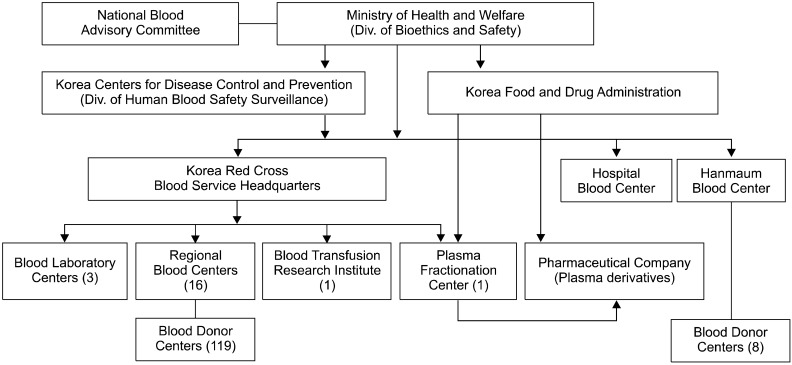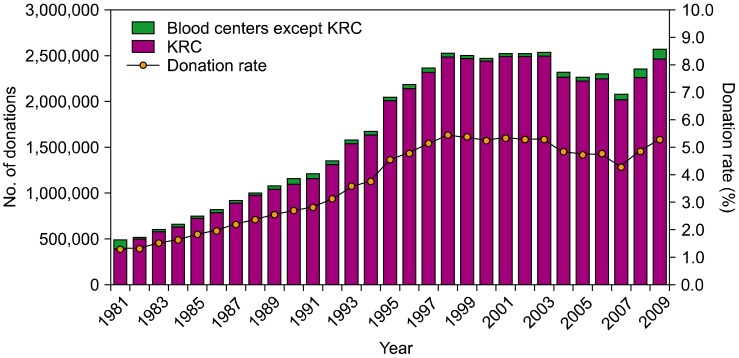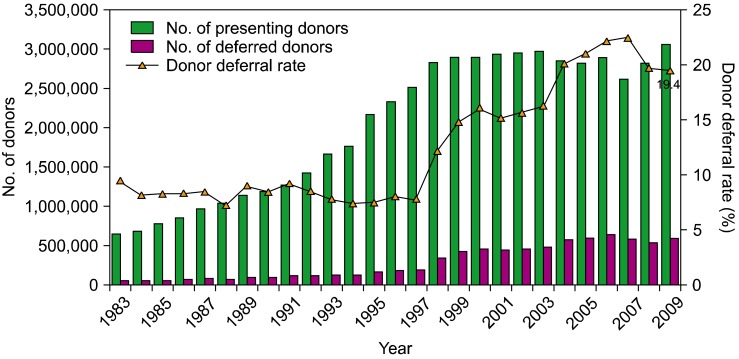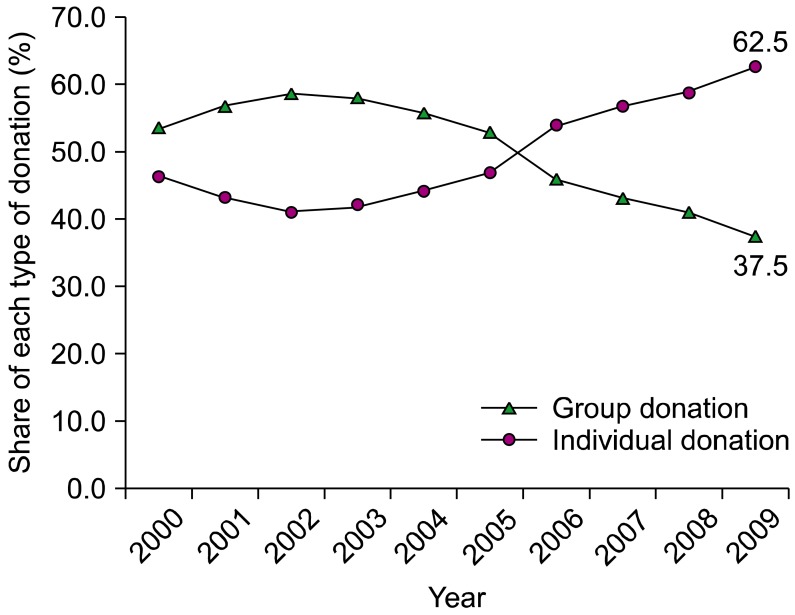Blood Res.
2013 Jun;48(2):139-144. 10.5045/br.2013.48.2.139.
Performance review of the National Blood Safety Improvement Project in Korea (2004-2009)
- Affiliations
-
- 1Department of Laboratory Medicine, Yonsei University College of Medicine, Seoul, Korea. hyunok1019@yuhs.ac
- 2Department of Biomedical Laboratory Science, Eulji University College of Health Science, Sungnam, Korea.
- 3Korea Centers for Disease Control and Prevention, Osong, Korea.
- KMID: 2172913
- DOI: http://doi.org/10.5045/br.2013.48.2.139
Abstract
- BACKGROUND
In 2004, the Korean government and blood transfusion community deliberated on the issue of a national blood system reform and agreed to implement a 5-year project (2004-2009) to further improve safety measures. Our study delineates the basis of the current national blood program and analyzes the performance of this 5-year project initiated by the Korean government.
METHODS
A performance review of the 5-year project was conducted from May 2009 to February 2010 using various approaches. Numerous data and documentation were collected from the Korean Red Cross and the Korean Centers for Disease Control and Prevention and reviewed by experts. Approximately 20 interviews with representatives of stakeholder groups were conducted to gather information, opinions, and perceptions. We conducted a nationwide field survey on a total of 144 blood donor centers.
RESULTS
Among the 5 major categories of the 5-year project, blood donor recruitment, laboratory testing, and product manufacturing were improved in terms of quality performance. Specifically, government's financial support ensured that the infrastructure of blood donor centers and blood laboratory centers improved. The pivotal role of the government contributed to improvements in the national blood program and enhanced national surveillance for blood safety.
CONCLUSION
Korea has made a tremendous effort with positive outcomes to provide safety measures for blood products for transfusion in its citizens. In all areas of blood management, from blood donations to transfusions, continuous developments in monitoring safety standards and practices are paramount.
MeSH Terms
Figure
Cited by 3 articles
-
Serious Adverse Transfusion Reactions Reported in the National Recipient-Triggered Trace Back System in Korea (2006-2014)
Jeong Ran Kwon, Eun Jeong Won, Hyun Jung Jo, Sae Rom Choi, Kyoungyul Lee, Sinyoung Kim, Hyeong Sik Ahn, Young Sill Choi, Duck Cho, Dong Han Lee
Ann Lab Med. 2016;36(4):335-341. doi: 10.3343/alm.2016.36.4.335.Towards better and safer blood transfusion
Duck Cho
Blood Res. 2013;48(2):71-71. doi: 10.5045/br.2013.48.2.71.Current State of Blood Management Services in Korea
Hyun Ok Kim
Ann Lab Med. 2022;42(3):306-313. doi: 10.3343/alm.2022.42.3.306.
Reference
-
1. World Health Organization. Global blood safety and availability facts and figures from the 2007 blood safety, 2009. Geneva, Switzerland: World Health Organization;2009. Accessed October 7, 2010. at http://www.who.int/bloodsafety/global_database/en/index.html.2. Farrugia A, Penrod J, Bult JM. Payment, compensation and replacement-the ethics and motivation of blood and plasma donation. Vox Sang. 2010; 99:202–211. PMID: 20576023.
- Full Text Links
- Actions
-
Cited
- CITED
-
- Close
- Share
- Similar articles
-
- Challenges and improvement opportunities in a telemedicine pilot project
- Framework for Continuous Assessment and Improvement of Occupational Health and Safety Issues in Construction Companies
- National Blood Policy for Safe and Adequate Blood Supply
- Application and Evaluation of the Pilot Program for the Education Nurse System in a Medical Institution
- An Overview of the Initiatives and Activities of the Korean Blood Safety Project Group over a Ten Year Period: 2012∼2021






